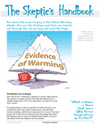This is one humdinger of a paper and it’s been a long time coming. It’s a big step forward in the search for the hot-spot. (If the hot spot were a missing person, McKitrick et al have sighted a corpse.) In 2006 the CCSP quietly admitted with graphs (in distant parts of various reports) that the models were predicting a hot spot that the radiosondes didn’t find (Karl et al 2006). Obviously this was a bit of a problem for the Scare Campaign. Much of the amplifying feedback created in the models also creates the hot-spot, so without any evidence that the hot-spot is occurring, there goes the disaster (and the urgent need for funding and junkets). Douglass et al officially pointed out the glaring deficiency in 2007. Santer et al replied in 2008 by discovering a lot of uncertainties, and stretching the error bars. Since the broad errors bars overlapped he could announce that the hot spot wasn’t really missing (even though he didn’t really find it either). He wrote this up in words effectively saying that the inconsistency in temperatures was not so inconsistent. McIntyre and McKitrick pointed out these key Santer results which used data up to 1999 were overturned with the use of data up to 2009. Somehow, despite all the excitement over Santer et al 2008, the IJOC decided updating it and contradicting it was “not interesting” and it took months to reach that banal conclusion. […]
|
|
||||
|
John Cook might be skeptical about skeptics, but when it comes to government funded committee reports, not so much. The author of “skeptical science” has finally decided to try to point out things he thinks are flaws in The Skeptics Handbook. Instead, he misquotes me, shies away from actually displaying the damning graphs I use, gets a bit confused about the difference between a law and a measurement, unwittingly disagrees with his own heroes, and misunderstands the climate models he bases his faith on. Not so “skeptical” eh John? He’s put together a page of half-truths and sloppy errors and only took 21 months to do it. Watch how I use direct quotes from him, the same references, and the same graphs, and trump each point he tries to make. His unskeptical faith in a theory means he accepts some bizarre caveats while trying to whitewash the empirical findings. In the end, John Cook trusts the scientists who collect grants funded by the fear-of-a-crisis and who want more of his money, but he’s skeptical of unfunded scientists who ask him to look at the evidence and tell him to keep his own cash. These two graphs are not the same […] Big names like Santer, Sherwood, and Schmidt admit that the models predict more warming 10 km above the equator than what the weather balloons could find. Each time they announce that they’ve resolved the differences, they have to start by admitting there are differences to resolve. […] The ‘Hotspot’ is crucial to the climate debate. If greenhouses gases are warming the planet that warming will happen first in the cold blob of air 8-12 km above the tropics. It’s freezing cold up there, but it ought to be slightly less freezing cold thanks to greenhouse gases. All 20-odd climate models predict warming there first—it’s the fingerprint of greenhouse gas warming, as opposed to warming by some other cause, like solar magnetic effects, volcanic eruptions, solar irradiance, or ozone depletion etc etc.
Look at A above, the greenhouse gas fingerprint is markedly different from the rest and dominates the overall predicted pattern in graph F. The big problem for the believers of AGW is that years of radiosonde measurements can’t find any warming, as shown in part E of Figure 5.7 in section 5.5 on page 116 of the US CCSP 2006 report
8.7 out of 10 based on 38 ratings […] |
||||
|
Copyright © 2025 JoNova - All Rights Reserved |
||||












Recent Comments